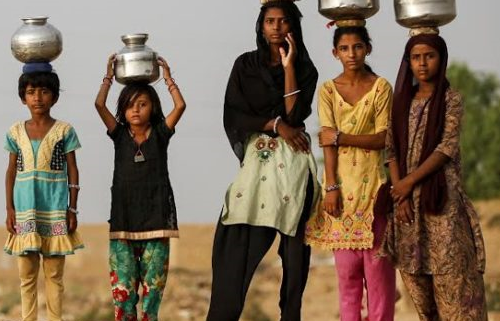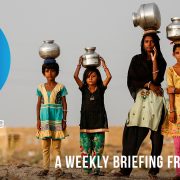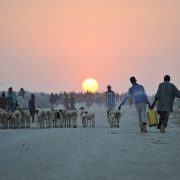What’s Up With Water – Brazil’s Water After Rupture of Mining Waste Dam, and More
Eileen Wray-McCann, for Circle of Blue, and here’s What’s Up with Water, your “need-to-know news” of the world’s water.
This Week’s Key Water Stories From Around The Globe.
In the United States, Arizona lawmakers approved a short-term plan for cutting water use from the Colorado River. Governor Doug Ducey signed the agreement six hours before a federal deadline for the seven basin states. When the time was up, the Bureau of Reclamation would have started to draft its own plan. The bureau, however, said that both Arizona and California missed the official deadline because not all key players had signed off on the agreements. Those states now have until mid-March to do so while the bureau gathers comments on its own plan for reducing water use.
The nonprofit Waterkeeper Alliance, along with two member organizations, has sued the U.S. Environmental Protection Agency. It said the agency failed to review important drinking water regulations on time. The suit alleges that the EPA missed deadlines for evaluating standards on chromium, solvents, Legionella bacteria, and other contaminants in U.S. drinking water.
In related news, the EPA does not plan to set drinking water limits on PFOA and PFOS chemicals. That’s according to two sources familiar with the agency’s upcoming decision. The toxic substances have been detected in groundwater near military bases and chemical plants, and are linked to cancer and other illnesses. The EPA, which says a final decision has not been made, says it will not discuss the contents of its chemical management plan until it is made public. A release date has not been set.
Last week, India and Pakistan rekindled the cooperative spirit of a river-sharing treaty that is nearly six decades old. A three-member team of Pakistani experts visited India to inspect hydropower projects under the Indus Water Treaty. They called the visit very successful and invited the Indian experts to visit Pakistan’s dam on the Indus river.
Zimbabwe’s second-largest city announced that it will implement water restrictions due to falling reservoir levels. Rationing in Bulawayo will begin with 36-hour cuts each week, and will be reviewed weekly.
In Saudi Arabia, nearly 300 people were rescued last week amid heavy rainfall and flooding. The severe weather has killed 12 and injured more than 170 people.
In Australia, a new royal commission’s evaluation of the Murray-Darling Basin Plan advises a complete overhaul of the controversial project. The 746-page report found incidences of maladministration, negligence, and unlawful actions in the creation and execution of the plan.
In other news, a team of scientists from The Australian National University recently spent several months gathering satellite data on water availability below the earth’s surface. The researchers found that the data could predict drought up to five months in advance. The team says space technology could prove invaluable in preparations for drought and bushfires.
And that’s the world water roundup.
We focus this week on Brazil, where the collapse of a massive dam containing mining waste has killed scores of people. It now threatens the water of hundreds of communities. Some critics point to weak environmental safeguards saying that this tragedy has happened before, and will happen again.
On January 25th, a dam at a mine in southeastern Brazil failed, releasing a tsunami of reddish-brown sludge that quickly engulfed
buildings, vehicles and parts of the nearby city of Brumadinho. At least 121 people are known dead, and a couple hundred remain missing. Rescuers say they have little hope of finding more survivors.
The sludge is composed of iron ore waste and mining by-products. It was stored in a huge containment area run by the big Brazilian mining company Vale SA. Now loose, and on the move, it has left deposits of up to 15 meters (or nearly 50 feet) deep in some areas. It continues to head down a tributary stream, threatening to contaminate a larger river that supplies drinking water to five of Brazil’s 26 states.
The Associated Press reported that the Paraopeba River, about 11 miles downstream from the ruptured waste dam, has turned brown, and residents have been warned to avoid using it, even for fishing. The Paraopeba flows into the larger Sao Francisco River, which provides drinking and irrigation water to hundreds of municipalities including larger cities.
As searches continue and communities mourn their dead, Brazilian officials and experts are attempting to mitigate water contamination.
They hope to use a hydroelectric dam and facility nearly 200 miles downstream from the spill site. If the dam’s reservoir can isolate the sludge, it could perhaps be remediated before the water is released to the Sao Francisco River. The sludge is expected to reach the dam between February 5th and 10th, according to Brazil’s National Water Agency. The operators of the hydroelectric dam say the wave of waste poses no structural risk to the dam.
However, the sludge, moving about a half mile an hour, is destroying vegetation and aquatic life.
Mining tailings, which contain high levels of iron ore particles or other heavy metals, can contaminate rivers for years or decades, according to the head of the Environmental Biophysics program at the Federal University of Rio de Janeiro. Vale SA, the waste dam operator, said the sludge did not have dangerous levels of metals, but experts countered that the environmental impact could be irreversible.
The Associated Press reported that Vale told them it was conducting water quality tests, but was awaiting results. In the meantime, the Brazilian environmental group SOS Mata Atlantica began its own testing last week near the site of the waste dam failure. Early data from that area of the [parrro-PEBB-ah] Paraopeba River showed low oxygen levels in the water, and high levels of nitrate and phosphate. The testers used methods developed by an independent water testing organization based in the United States. The results showed that in that location, water quality had dropped nearly 30 index points, or from “Good” to “Bad.” One biologist present said that only a few fish species could survive such conditions, and dead fish were seen floating along the river several miles from the failed dam.
Experts warned that even if water tests do not show dangerous levels of toxicity, the high levels of iron and aluminum could alter the riverbed and harm the ecosystem.
It is a scenario that has played out before in Brazil. In 2015, about 80 miles away from the current tragedy, a much larger waste reservoir collapsed. The dam rupture was in the city of Mariana, and it also involved Vale, that time as a co-operator. 19 people perished, thousands of fish died, and 250 thousand people lost their drinking water. After three years, say environmental experts, the river water is still not drinkable. Iron oxide that has settled in the riverbed is stirred to the surface with each heavy rain.
Environmentalists draw close comparisons to the dam failures in 2015 and 2019. Even if most of the waste is removed, said one, the residues will remain for a long time, depressing the return of life.
A 2017 report from the National Water Agency listed over 700 dams across Brazil as highly vulnerable to collapse, with high potential for causing damage.
Local groups argue that the latest incident is no accident, and demand that the mining operator should be prosecuted for “one of the biggest environmental crimes” Brazil has ever seen.
Brazilian authorities made five arrests last week in connection with the dam failure: three Vale employees and two others from the German company that inspected the dam. Vale promised to support the investigation.
An official report on the causes of the dam failure is pending, but experts and lawmakers point to poor regulation, understaffing and the exclusion of environmental voices in the licensing process.
As Brazilian leadership eases restrictions in pursuit of economic growth, regulation of the mining industry has gotten weaker, not stronger, since the 2015 mining dam rupture that was considered Brazil’s worst ecological disaster to date. Environmentalists are expecting further regulatory rollbacks under the current president, Jair Bolsonaro.
The local politics are also sympathetic to the mining industry. The name of the state itself, Minas Gerais, or “General Mines” reflects the cultural connection. Thousands of residents, many in poor, rural areas, depend on about 300 mines for their livelihoods. Social justice groups have little leverage for winning basic guarantees such as protecting drinking water from mining contamination. A 2016 audit revealed that the state agency in charge of regulating mines had only 20 percent of the staff needed. And the decision-makers are increasingly pro-mining. Friends of the industry are replacing environmental advocates on the board that approves mining licenses and influences regulatory oversight.
Half a year before this latest disaster in Brumadinho, lawmaker Joao Vitor Xavier told the state assembly that he had no doubt more dams would rupture. His prediction was not long in coming true. Last week he told the Associated Press he is certain there will be still more tragedies unless tighter controls take hold.
“These dams are not 100 percent safe,” he said, “How many of them can rupture? Any one of them.”
This week’s featured story from Circle of Blue looks at tribal water rights in the Colorado River basin.
With the endorsement of its members, a tribe with one of the largest and most secure claims to water in the basin will seek approval from Congress to lease water outside the boundaries of its riverside reservation.
The Colorado River Indian Tribes have lands that stretch along 56 miles of the lower Colorado River. Most of the reservation is in Arizona, with a small part in California. The Colorado River Indian Tribes have enormous influence in the Colorado River Basin, holding the rights to roughly 20 percent of the water.
By law, that water is restricted to use on the reservation. But if the tribal group convinces Congress to allow off-reservation leasing, the change would free up a large volume of water. That water would be very appealing to cities and industries in Arizona’s fast-growing Sun Corridor, spanning Phoenix and Tucson, where four out of five state residents live.
The tribal members signaled their approval on January 19, with 63 percent voting to seek legal changes for leasing. The vote was a response to dissention over the issue. Last spring, tribal council members faced a recall attempt by residents who objected to leasing water to outside interests.
Tribes in central Arizona are already allowed to lease water, a privilege that was negotiated in 2004 during water rights settlements. Last year, those tribes leased about 128,000 acre-feet of water.
The Colorado River Indian Tribes has suggested that it could make as much as 150,000 acre-feet available in the coming decades, a volume of water that would more than double the current market.
The Colorado River Indian Tribes’ water is especially desirable because their rights are among the most senior in the state, meaning they would be fulfilled before other users if all claims to the river cannot be delivered. The flow of the Colorado is declining and the addition of heat-trapping gases in the atmosphere is causing the basin to become drier.
Robert Glennon, a water policy expert at the University of Arizona told Circle of Blue “The tribe is absolutely critical to the willingness of the parties in Arizona to go forward with the drought plan.”
And that’s What’s Up With Water…we’d like to know what’s up where you are – Tweet us with your water news @circleofblue #whatsupwithwater.
Eileen Wray-McCann is a writer, director and narrator who co-founded Circle of Blue. During her 13 years at Interlochen Public Radio, a National Public Radio affiliate in Northern Michigan, Eileen produced and hosted regional and national programming. She’s won Telly Awards for her scriptwriting and documentary work, and her work with Circle of Blue follows many years of independent multimedia journalistic projects and a life-long love of the Great Lakes. She holds a BA and MA radio and television from the University of Detroit. Eileen is currently moonlighting as an audio archivist and enjoys traveling through time via sound.













“Recent data from the World Meteorological office showed that 2018 was the fourth warmest on record, making the last four years the hottest four years in Earth’s recorded history.” TruthOut
“2019’s carbon dioxide concentration is expected to average around 411.3 parts per million.
The monthly average will peak in May at around 414.7 parts per million and lower to 408.1 parts per million in September before rising again at the end of the year.
It is typical for atmospheric carbon dioxide levels to fluctuate throughout the year, falling in the summer when more green leaves are around to absorb the greenhouse gas and rising in the winter when trees are bare.
“The Mauna Loa graph of atmospheric CO2 is a thing of beauty, but also a stark reminder of human impact on climate,” Betts said. “Looking at the monthly figures, it’s as if you can see the planet ‘breathing’ as the levels of carbon dioxide fall and rise with seasonal cycle of plant growth and decay in the northern hemisphere.
But each year’s CO2 is higher than the last, and this will keep happening until humans stop adding CO2 to the atmosphere.” Olivia Rosane
“Right now the course of our future is being set by the fossil fuel industry, the most powerful corporations in the history of the world, and they’re steering us off a cliff into a raging inferno.
They fight each day to blow up more mountains for coal, demolish more land and oceans for oil and shatter more of the ground beneath our feet by fracking for oil and gas with a cocktail of the most toxic chemicals known to humankind.
With each passing day that these interests set our course, with every additional ton of greenhouse gases emitted like a poison in our atmosphere, the drier the ink becomes on the bleak future written by the fossil fuel industry.
That future is one where oceans drown our coastal homes and cities, where biodiversity is diminished.
It’s a future where droughts will parch our agricultural fields and allow wildfires to run rampant.
It’s a future where clean, freshwater will be among the world’s scarcest resources, and where smog and pollution suffocate our lungs and the planet’s.
Given the fossil fuel industry’s seemingly unlimited money and political influence, changing their course and taking control of our future is a tall order.
But again, we must. And all of you, can make the choices that lead you to seize that control.
I can tell you how significant a difference each of us can make, how important the choices we make can be and the power we have in this country.” John Armstrong
An ideal Carbon Atmosphere, would be at 300 parts per million
1700s to 1800s ppm Carbon 260ppm – 280ppm
1980s ppm carbon 350
2015s ppm of Carbon 405
2017 ppm of Carbon 409.35 and Rising
“I will show you the rise in CO2 levels every 5 years from 1958 to Dec. 2017. I will also show the CO2 difference beside it from the previous reading. Each reading is taken in the March of the respective year.
Year…………………….CO2 Levels……………Growth
1958……………………315.71…………………..<4.0
1963……………………319.86…………………..4.15
1968……………………323.89…………………..4.03
1973……………………330.30…………………..6.41
1978……………………336.66…………………..6.36
1983……………………343.33…………………..6.67
1988……………………352.41…………………..9.08
1993……………………358.47…………………..6.06
1998……………………367.24…………………..8.77
2003……………………376.46…………………..9.22
2008……………………386.03…………………..9.57
2013……………………397.43…………………..11.40
2017……………………409.01…………………..12.42
"The last entry is early since it is March 2018.
This shows the ever increasing growth of CO2 levels in our atmosphere.
Some 2017 figures have shown 410ppm over the year, giving an increase of nearly 1ppm per month."
Can society even exist in it's current form at 600ppm CO2 concentration ?
I know the planet has been at that level before, but it took tens of thousands of years to get there and back again, not 250 years.
Add in the CH4 levels, and you have an equivalence of ~580ppm already." Mark Bevis
"I asked him what he would say to people who think we still have time to mitigate the impacts of runaway climate change.
"We can't undo this," he replied. "How are you going to cool down the ocean? We're already there."
As if to underscore the point, Wanless told me that, in the past, carbon dioxide had varied from roughly 180 to 280 parts per million (ppm) in the atmosphere as the Earth shifted from glacial to interglacial periods.
Linked to this 100-ppm fluctuation was about a 100-foot change in sea level.
"Every 100-ppm CO2 increase in the atmosphere gives us 100 feet of sea level rise," he told me. "This happened when we went in and out of the Ice Age."
As I knew, since the industrial revolution began, atmospheric CO2 has already increased from 280 to 410 ppm.
"That’s 130 ppm in just the last 200 years," I pointed out to him.
"That’s 130 feet of sea level rise that’s already baked into Earth's climate system."
He looked at me and nodded grimly. I couldn’t help thinking of that as a nod goodbye to coastal cities from Miami to Shanghai." Dahr Jamail
There is 20 feet of Sea Level Rise in Greenland
There is 200 Feet of Sea Level Rise in Antarctica
Melting and Calving Now !
My Guess in 2014 was that the 220 feet of Sea Level Rise will come between 415ppm – 420ppm of Carbon in are Atmosphere
What will methane be ?
We have increased Global Temps 1.7C. and Climbing, since the 1700s
For Every 1C. Temp Rise There is 7% more moisture Added To the Atmosphere Creating Record Rains Each Year, Do You Dare Imagine the Future ?
Already at 10% more moisture it has Doubled Record Rain Fall, We are Accelerating to 2C. in Months by 2020 ?
What will Record 14% more Moisture in the Atmosphere be in Record Rain ? in 2020 ?
Florence – Global Warming Abrupt Climate Change sea Level Rising over 220 Feet Way Faster Than They Say Way Faster Than You Think
Sandy, Katrina, Irma, Maria, an Harvey had 19% to 49% more Record Rain, Record Winds, Record Sea Surges,
Our New Normal
Record Rain, Record Snow,
Record Highs Record Lows
Record Winds, Record Waves,
Record Fires, Record Floods,
Record Volcanic Eruptions
Record Hurricanes, Record Tsunamis,
Record Typhoons, Record Earthquakes,
Record Mud-Slides, an Record Sea Surges.
Glaciation kept the Mantle Cooler, Mantle is Heating up, The Accelerated Melt is Going to Be Horrendous, Horrific, and Tsunamic 1,500 feet, Way Faster Than they are Saying, Way Faster Than You Think
The Main Priority Now Should be to Decommission and Relocate to Above 3,000 Feet,
444 Nuclear Reactors at Sea Level Now.
1,200 Nuclear Fuel Rod Facilities at Sea Level Now.
14,300 Nuclear Weapons
250,000 Toxic Tons of
Radiated Nuclear Waste Globally
How long before 5 feet of Greenlands 20 Feet of Sea Level Rise
Fukushimatizes us ? 2022 ?
Antarctica has over 200 feet of Sea Level Rise
Will The Crust Vaporize in to the Mantle ?
When Salt Water Shuts Down The Cooling Systems of These Reactors and Facilities .